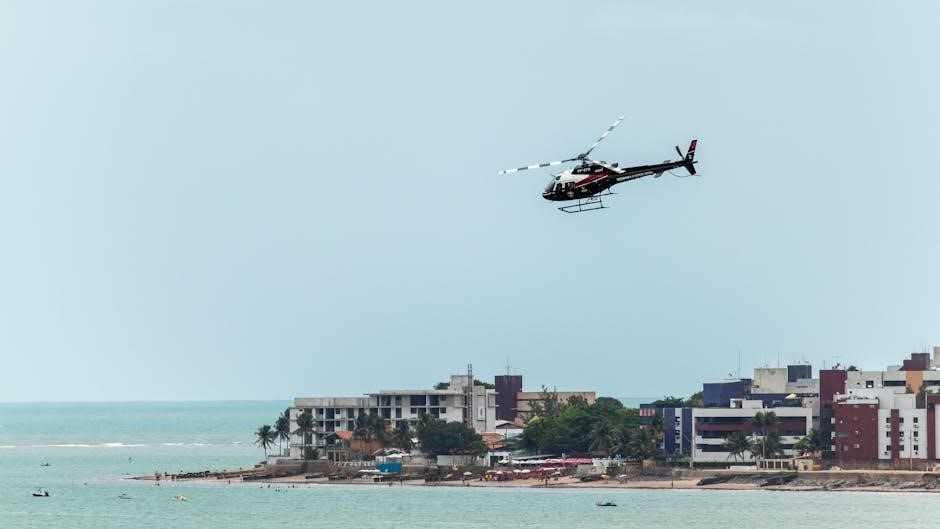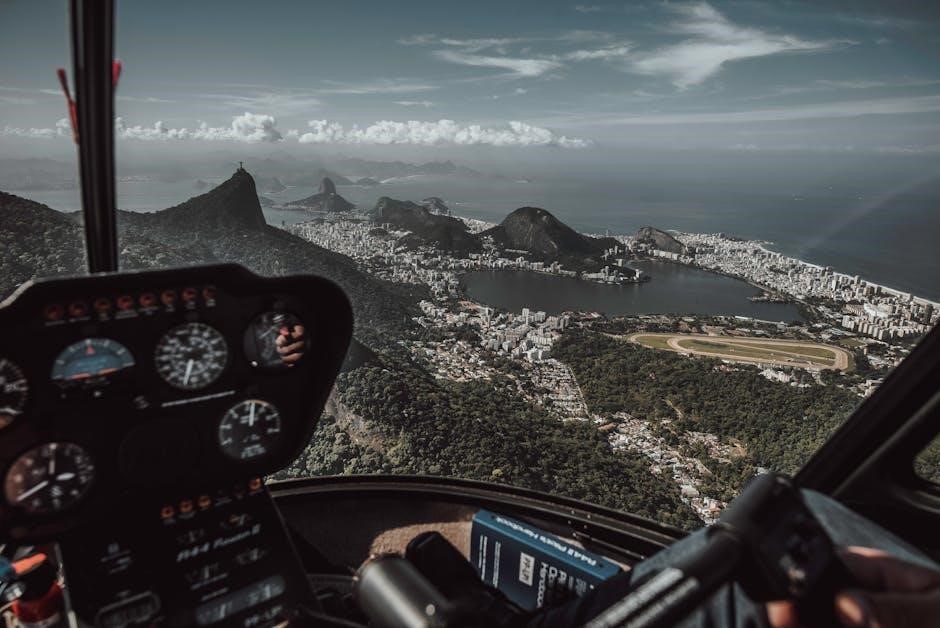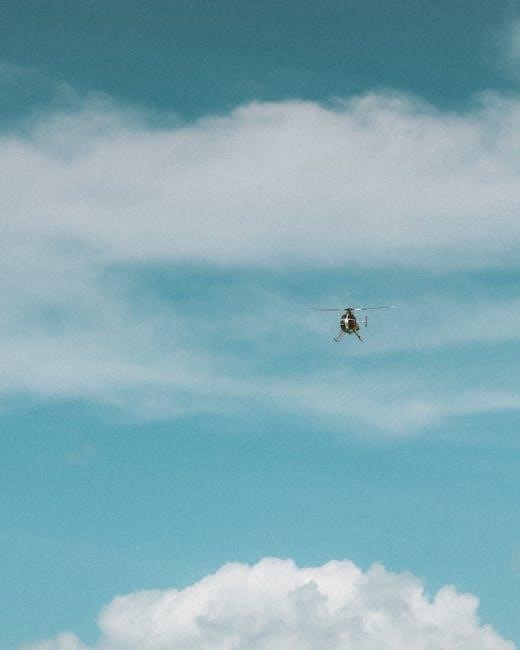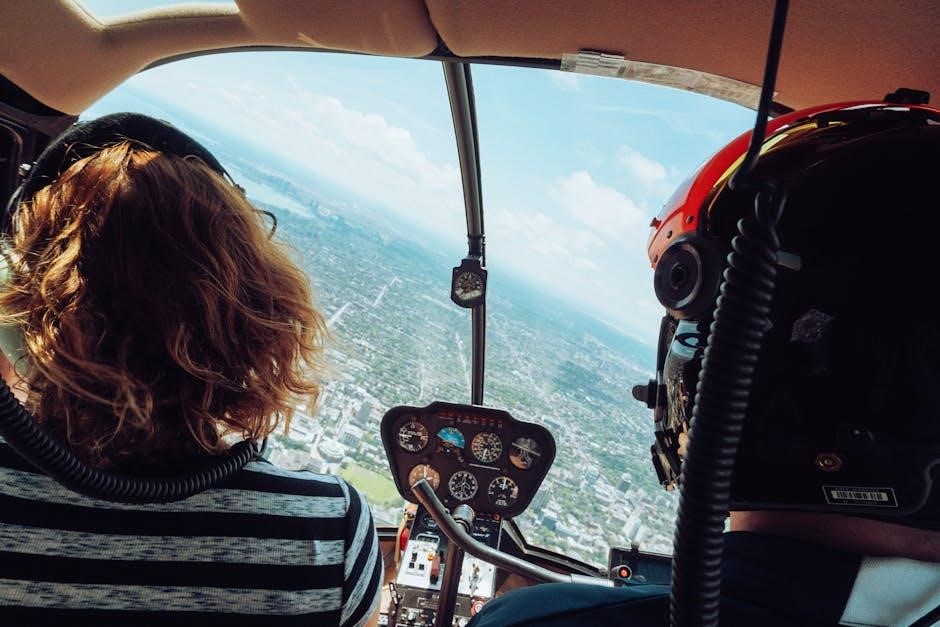The Sky Rover Stalker Helicopter is a popular 3-channel infrared remote-controlled toy designed for both beginners and experienced enthusiasts. Known for affordability and accessibility‚ it offers hours of entertainment with versatile movements‚ including rising‚ falling‚ turning‚ and moving forward or backward; Its turbo engine and precise control system make it ideal for performing tricks and stunts‚ while its smart circuit protection ensures safe operation. With a flight time of over 6 minutes and a control distance of up to 10 meters‚ this helicopter provides an engaging and fun flying experience for all users.
Overview of the Sky Rover Stalker Helicopter
The Sky Rover Stalker Helicopter is a versatile and engaging 3-channel infrared remote-controlled toy designed for both indoor and outdoor use. It features a turbo engine for powerful performance and a smart circuit protection system to ensure safe operation. With its precise control system‚ users can perform a variety of movements‚ including rising‚ falling‚ turning‚ and moving forward or backward. The helicopter is equipped with a USB charging cable and includes extra blades for easy replacement. Its compact design and lightweight construction make it ideal for beginners and experienced flyers alike‚ offering an exciting and enjoyable flying experience.
Features and Specifications
The Sky Rover Stalker Helicopter boasts a range of impressive features‚ including a 3-channel infrared (IR) control system for precise maneuvering. It is equipped with a powerful turbo engine‚ providing swift response times and smooth operation. The helicopter includes smart circuit protection for added safety and durability. Key specifications include a 7.4V 1500mAh Li-Po battery‚ offering over 6 minutes of flight time‚ and a control distance of up to 10 meters. Its lightweight and compact design‚ measuring 690mm in length and 110mm in width‚ make it ideal for both indoor and outdoor use. Additional features include spare blades and a USB charging station for convenience.
Why Choose the Sky Rover Stalker Helicopter?
The Sky Rover Stalker Helicopter is a top choice for RC enthusiasts due to its exceptional performance‚ durability‚ and ease of use. Its affordability and accessibility make it ideal for both beginners and experienced flyers. The helicopter’s 3-channel IR control system and turbo engine ensure smooth and precise maneuvers‚ while its smart circuit protection enhances safety. With a detailed guide included‚ users can master its features and troubleshooting effortlessly. Perfect for all skill levels‚ the Stalker offers a fun and engaging flying experience‚ making it a standout option in the world of remote-controlled helicopters.

Unboxing and Initial Inspection
The Sky Rover Stalker Helicopter arrives in a well-packaged box‚ containing the helicopter‚ remote control‚ batteries‚ charger‚ and spare parts. Initial inspection ensures all components are undamaged and accounted for‚ with clear instructions provided for a smooth start.
Unboxing the Sky Rover Stalker Helicopter
The Sky Rover Stalker Helicopter arrives in a neatly packaged box‚ containing the helicopter‚ remote control‚ a USB charging cable‚ and a set of spare parts. The box also includes an instruction manual that provides step-by-step guidance for assembly‚ charging‚ and initial flight preparation. Upon opening‚ ensure all components are in pristine condition and accounted for. The helicopter is securely nestled in protective foam to prevent damage during shipping. Take a moment to familiarize yourself with the contents before proceeding to the next steps. This ensures a smooth and enjoyable experience right out of the box.
Initial Inspection and Checking for Damages
Begin by carefully inspecting the Sky Rover Stalker Helicopter and its components for any signs of damage or wear. Check the rotor blades‚ tail rotor‚ and main motor for proper alignment and integrity. Ensure the remote control functions correctly and all buttons respond as expected. Examine the battery and charging cable for any visible defects or frays. Verify that all screws and parts are securely fastened. If any damage is found‚ contact the manufacturer or seller before proceeding. This step ensures your helicopter is in perfect condition for safe and enjoyable operation.

Understanding the Components
The Sky Rover Stalker Helicopter includes a main rotor‚ tail rotor‚ lithium battery‚ remote control‚ and charging station. These components work together to ensure smooth and precise flight.
Main Parts of the Sky Rover Stalker Helicopter
The Sky Rover Stalker Helicopter features a durable design with essential components for optimal performance. It includes a main rotor for lift‚ a tail rotor for stability‚ and a powerful turbo engine. The helicopter is equipped with a rechargeable 7.4V 1500mAh Li-Po battery‚ ensuring extended flight times. Additional parts like spare blades‚ a tail rotor‚ and a charging station are provided for convenience. The remote control‚ with its intuitive design‚ allows for precise maneuvering. These components work together to deliver a smooth and enjoyable flying experience.
Accessories Included in the Package
The Sky Rover Stalker Helicopter package includes essential accessories for a complete flying experience. These include a USB charging wire for the 7.4V 1500mAh Li-Po battery‚ ensuring safe and efficient charging. Additionally‚ the package comes with extra tail rotors and spare blades‚ providing replacements in case of damage. A detailed user manual is also provided‚ offering step-by-step instructions for setup‚ operation‚ and troubleshooting. These accessories ensure that users have everything needed to enjoy their helicopter right out of the box‚ enhancing both performance and longevity.

Assembly and Setup
The Sky Rover Stalker Helicopter requires minimal assembly‚ with a user manual guiding you through attaching rotors and ensuring proper installation of the battery compartment.
Physical Assembly of the Helicopter
The Sky Rover Stalker Helicopter requires minimal assembly‚ focusing on attaching the main rotor‚ tail rotor‚ and securing the battery compartment. Start by carefully unpacking all components and ensuring no parts are damaged. Follow the manual to align and screw the rotors firmly into place‚ avoiding over-tightening. Next‚ attach the tail blades and ensure proper alignment for balanced flight. Finally‚ secure the battery door and verify all connections are tight. Double-check for any loose parts before proceeding to calibration; This straightforward process ensures the helicopter is flight-ready in minutes.
Calibration and Initial Setup Instructions
Proper calibration is essential for smooth operation of the Sky Rover Stalker Helicopter. Begin by turning on the remote control and ensuring the helicopter is placed on a flat surface. Allow the gyro to stabilize by keeping the throttle at minimum. Use the trim buttons on the remote to adjust the rotor balance‚ ensuring the helicopter hovers evenly. Next‚ sync the remote with the helicopter by following the LED indicator instructions. Finally‚ test the controls gently to confirm responsiveness. Refer to the manual for detailed calibration steps to ensure optimal performance.

Battery Installation and Charging
Insert the Li-po battery into the helicopter‚ ensuring correct polarity. Connect it securely and charge using the provided USB cable. Charging takes approximately 40 minutes. Avoid overcharging.
Installing the Battery Correctly
To install the battery correctly‚ locate the battery compartment on the Sky Rover Stalker Helicopter. Open it by sliding the cover or removing the screws‚ depending on the model. Insert the provided Li-po battery‚ ensuring the positive terminal faces the correct direction as indicated by the compartment’s markings. Secure the battery with the included straps or clips to prevent movement during flight. Close the compartment tightly and ensure it is locked in place. Always handle the battery with care to avoid damage‚ and never force it into the compartment. Proper installation ensures safe and optimal performance.
Charging the Battery: Best Practices
For the Sky Rover Stalker Helicopter‚ charging the 7.4V 1500mAh Li-po battery requires care to ensure longevity. Connect the battery to the provided USB charger and plug it into a compatible power source. The charging time is approximately 40 minutes for a full charge. Ensure the helicopter is turned off during charging to prevent power drain. Avoid overcharging‚ as it may damage the battery. Use only the included charger to maintain safety and compatibility. A full charge is indicated by the LED light turning solid. Store the battery in a cool‚ dry place when not in use.
Flight Preparation
Before flying‚ ensure the area is clear of obstacles and people. Conduct a pre-flight check of the helicopter and remote control to ensure proper functionality.
Pre-Flight Checks and Safety Precautions
Before each flight‚ ensure the Sky Rover Stalker Helicopter is in proper working condition. Check the battery for a full charge and verify that all parts‚ including blades and motors‚ are securely attached. Inspect the remote control for responsive sticks and ensure the infrared signal is clear. Choose a wide‚ open space free of obstacles‚ people‚ and pets. Avoid flying near fragile objects or in harsh weather conditions. Always maintain a safe distance from bystanders and ensure adult supervision for younger users. Never fly near sensitive electronic equipment or in confined areas;
Understanding the Remote Control Functions
The remote control of the Sky Rover Stalker Helicopter is designed for intuitive operation. The left and right dials control rotation‚ allowing the helicopter to turn left or right. The throttle lever on the left adjusts altitude‚ enabling the helicopter to ascend or descend. The remote also features a light switch in the center to toggle the LED light on the helicopter’s nose. Ensure the remote is fully functional before each flight‚ and familiarize yourself with its layout to master precise control and enjoy smooth maneuvers. Proper handling of the remote is key to a successful flying experience.
Basic Flight Training
Start by mastering the basics: begin with engine ignition‚ gradual throttle increase for smooth liftoff‚ and steady hovering. Practice forward‚ backward‚ and sideways movements to build control confidence.
Starting the Engine and Lifting Off
To begin‚ place the Sky Rover Stalker Helicopter on a flat‚ stable surface. Ensure the area is clear of obstacles and turn on the remote control. Insert the batteries into the helicopter as per the manual. Gently push the left stick (throttle) upward to start the engine. Allow the rotor blades to spin slowly before gradually increasing the throttle for liftoff. Use the trim buttons on the remote to adjust balance and ensure stable hovering. This step is crucial for mastering basic flight control and preparing for more advanced maneuvers. Always maintain calm and steady movements for a smooth takeoff.

Throttle Control and Hovering Techniques
Mastering throttle control is essential for smooth flight. Start by gradually increasing the throttle to lift off the ground. Once airborne‚ adjust the throttle to maintain a steady hover. Use the trim buttons on the remote to balance the helicopter and prevent drifting. For stable hovering‚ keep the throttle steady and make small adjustments as needed. The Sky Rover Stalker features a stable flight system‚ making it easier to maintain position. Practice in an open area to refine your control and achieve a perfect hover. Consistent throttle management is key to mastering basic flight maneuvers.
Basic Forward‚ Backward‚ and Sideways Movements
To achieve smooth forward‚ backward‚ and sideways movements‚ use the left joystick on the remote control. Pushing the joystick forward will move the helicopter ahead‚ while pulling it back will reverse the motion. For sideways movement‚ move the joystick left or right. Start with small‚ gradual inputs to maintain control. The Sky Rover Stalker responds well to precise commands‚ allowing for accurate navigation. Practice these movements in an open space to build confidence and improve your piloting skills. Consistent control will enhance your ability to maneuver effortlessly.

Advanced Flight Techniques
The Sky Rover Stalker Helicopter excels in advanced maneuvers‚ including loops‚ sharp turns‚ and mid-flight stabilization. Its 3-channel IR system enables precise control for dynamic tricks and responsive handling.
Performing Loops and Tricks
To perform loops and tricks with the Sky Rover Stalker Helicopter‚ start by ensuring the helicopter is at a safe altitude. For a loop‚ push the throttle to full and use the elevator to guide the helicopter upward. Once inverted‚ gently pull back on the throttle to complete the loop. Practice inverted flights by holding the elevator in the negative position‚ then use the tail rotor to stabilize. For sharp turns‚ apply quick lateral movements with the remote. Always maintain smooth control and use the gyro system for mid-flight stabilization. These techniques require precision and practice to master‚ but they add excitement to your flying experience.
Sharp Turns and Precision Maneuvering
For sharp turns and precision maneuvering with the Sky Rover Stalker Helicopter‚ use the remote’s lateral controls gently but firmly. Apply quick‚ precise movements to the left or right to initiate sharp turns. The helicopter’s 3-channel IR system ensures responsive control‚ allowing for tight rotations and accurate positioning. To maintain stability during maneuvers‚ utilize the tail rotor for counter-rotation. For added precision‚ ensure the helicopter’s center of gravity is balanced‚ enhancing agility. Practice gradual control inputs to master sharp turns and enjoy precise‚ controlled flights.
Stabilizing the Helicopter in Mid-Flight
To stabilize the Sky Rover Stalker Helicopter in mid-flight‚ start by ensuring a steady throttle input to maintain altitude. Use the remote’s lateral controls to adjust the helicopter’s balance‚ gently moving the sticks to counteract any tilting. The tail rotor plays a crucial role in stability; adjust its pitch to minimize unwanted rotation. Fly in open‚ calm environments to reduce wind interference. Practice hovering at a low altitude to refine your control over the aircraft. Regularly check the helicopter’s center of gravity and ensure all components are securely fastened for optimal performance.

Troubleshooting Common Issues
The Sky Rover Stalker Helicopter may face issues like the receiver LED blinking continuously or no response to commands. Check the remote control’s batteries and ensure it’s turned on. Verify proper installation of the helicopter’s battery and ensure it’s fully charged. If issues persist‚ refer to the user manual for detailed diagnostic steps and solutions. Always ensure proper synchronization between the remote and helicopter before flight. Regular maintenance can prevent many common problems.
Diagnosing Common Problems
Identifying issues with the Sky Rover Stalker Helicopter often starts with observing its behavior. If the helicopter doesn’t respond to controls‚ check the remote batteries and ensure it’s turned on. Verify the receiver LED is blinking‚ indicating proper power. For no lift or uneven flight‚ inspect the blades for damage or improper alignment. Battery issues may cause short flight times; ensure it’s fully charged and properly installed. If the helicopter drifts‚ calibrate the gyro by centering the sticks and turning off interference sources. Always refer to the manual for detailed diagnostic steps.
Solving Issues with the Remote Control
If the remote control isn’t functioning properly‚ start by checking the batteries. Ensure they are fully charged or replaced with new ones. Turn the remote off and on to reset it. If issues persist‚ verify that the remote is paired correctly with the helicopter. In case of signal interference‚ move to an open area away from other electronic devices. Clean the remote’s joysticks and contacts with a soft cloth. For persistent problems‚ recalibrate the gyro by centering the sticks and following the manual’s instructions. Always ensure smooth communication between the remote and the helicopter for optimal performance.
Repairing Damaged Parts and Components
For damaged parts‚ start by assessing the extent of the damage. Replace broken blades or tail rotors using the spare parts provided. Tighten any loose screws or connections. If electrical components are faulty‚ check for frayed wires or poor connections and repair them carefully. For motor issues‚ ensure proper alignment and lubrication. Always use compatible replacement parts to maintain performance. After repairs‚ recalibrate the gyro and test the helicopter in a safe‚ open area. Regular maintenance and careful handling can prevent future damage and extend the lifespan of your Sky Rover Stalker Helicopter.

Maintenance and Upkeep
Regularly inspect and clean the helicopter to ensure optimal performance. Lubricate moving parts and replace worn components like blades or motors to maintain efficiency and longevity.
Cleaning and Servicing the Helicopter
Regular cleaning is essential to maintain the Sky Rover Stalker Helicopter’s performance. Use a soft cloth to wipe down the exterior‚ removing dirt or debris that may affect flight. Avoid harsh chemicals‚ as they can damage the surface. Inspect the blades and motors for wear and tear‚ ensuring they are free from obstructions. Lubricate moving parts periodically to reduce friction and extend lifespan. For internal servicing‚ refer to the manual for guidance on proper disassembly and reassembly. Routine maintenance ensures smooth operation and prolongs the helicopter’s lifespan.
Lubrication and Care for Moving Parts
Proper lubrication is crucial for the smooth operation of the Sky Rover Stalker Helicopter. Apply a small amount of silicone-based lubricant to the main motor‚ tail motor‚ and gear components to reduce friction and wear. Avoid over-lubrication to prevent attracting dust. Regularly inspect and clean moving parts to ensure optimal performance. Use a soft brush to remove dirt or debris from gears and bearings. Lubricate after cleaning to maintain efficiency. This care extends the lifespan of the helicopter and ensures reliable flight operations.
Replacing Worn-Out Blades and Motors
Replacing worn-out blades and motors on the Sky Rover Stalker Helicopter is essential for maintaining performance and safety. Start by powering off the device and removing the battery. Gently detach the damaged blades or motors‚ taking care not to strip any screws. Install the new components securely‚ ensuring proper alignment. Tighten all screws firmly but avoid over-tightening. Reconnect the motors to the control system and test the helicopter at a low throttle to ensure smooth operation. Regular replacement of worn parts prevents further damage and ensures optimal flight performance.
Safety Guidelines
Always ensure adult supervision when operating the Sky Rover Stalker Helicopter. Keep a safe distance from obstacles and avoid flying near people or pets. Operate in open spaces‚ maintaining control within the 10-meter range to prevent accidents or damage. Ensure the helicopter is used responsibly and in accordance with local regulations.
General Safety Precautions
Always prioritize safety when operating the Sky Rover Stalker Helicopter. Ensure adult supervision for minors and avoid flying near people‚ pets‚ or fragile objects. Keep the helicopter away from obstacles and avoid flying in confined spaces. Never operate near flammable materials or in wet conditions. Properly charge the battery in a well-ventilated area‚ avoiding overcharging. Ensure the helicopter is turned off before handling. Follow all local regulations and guidelines for responsible operation. Always land safely and avoid sudden maneuvers that could cause accidents.
Recommended Flying Zones and Environments
The Sky Rover Stalker Helicopter is suitable for both indoor and outdoor flying‚ offering versatility in different environments. For indoor use‚ ensure a spacious‚ obstacle-free area with high ceilings to accommodate vertical movements. Outdoors‚ choose open spaces like parks or empty fields with minimal wind interference. Avoid flying in harsh weather conditions such as strong winds‚ rain‚ or extreme temperatures. Always select environments free from obstacles‚ ensuring a safe and enjoyable flying experience. Properly assess the area before takeoff to maximize performance and prevent potential damage.
Emergency Landing Procedures
In case of an emergency‚ remain calm and follow these steps to ensure a safe landing; Reduce the throttle gradually to descend slowly and avoid sudden drops. Identify a clear‚ open area free from obstacles or people. Gently maneuver the helicopter to the chosen spot‚ maintaining control throughout the descent. Once landed‚ turn off the engine immediately to prevent any accidental movement. Always prioritize safety and avoid panic‚ as smooth control is key to a successful emergency landing. Ensure the area is secure before approaching the helicopter.

Upgrading and Customization
Enhance your Sky Rover Stalker Helicopter with performance upgrades like improved motors or custom paint jobs. Personalize its design to reflect your style for a unique flying experience.
Upgrading the Helicopter for Better Performance
Enhance your Sky Rover Stalker Helicopter with upgrades such as high-performance motors or advanced propellers for improved speed and agility. Consider upgrading the battery to a higher mAh Li-po for extended flight time. Additionally‚ installing a more responsive gyro system can improve stability and control. Customizing the helicopter with lightweight materials or aerodynamic designs can also boost performance. For enthusiasts‚ upgrading the transmitter to a 2.4 GHz system ensures better signal strength and range. These upgrades can significantly enhance your flying experience and overall satisfaction with the helicopter.
Customizing the Design and Appearance
Personalize your Sky Rover Stalker Helicopter by adding unique decals‚ paint jobs‚ or custom designs to make it stand out. Users can choose from various color schemes‚ such as the sleek green model‚ or opt for custom wraps. Additional LED lights can be installed to enhance visibility and style during flights. For a more personalized touch‚ enthusiasts can modify the helicopter’s exterior with creative paint jobs or stickers. These customizations allow users to express their individuality while maintaining the helicopter’s performance and functionality.
Mastering the Sky Rover Stalker Helicopter is a rewarding journey. With practice‚ you’ll unlock its full potential‚ enjoying seamless flights and continuous improvement. Happy flying!
Final Tips for Enjoying Your Sky Rover Stalker Helicopter
Consistently practice to refine your flying skills and explore various environments. Regularly inspect and maintain the helicopter to ensure optimal performance. Utilize the instruction manual for troubleshooting and optimization tips. Experiment with advanced techniques and customization to enhance your experience. Always follow safety guidelines and recommended flying zones. Embrace the learning process and enjoy the thrill of mastering your Sky Rover Stalker Helicopter. Happy flying and share your adventures with fellow enthusiasts!
Encouragement to Explore and Practice
Embrace the joy of flying by exploring the full potential of your Sky Rover Stalker Helicopter. Dedicate time to practice and master both basic and advanced maneuvers. Start in open spaces to build confidence‚ then gradually challenge yourself with tighter spaces and precise movements. Share your progress with friends or online communities to inspire others. The more you practice‚ the more you’ll discover the thrill of controlling your helicopter with precision. Keep experimenting‚ and enjoy the rewarding experience of improving your skills!

Leave a Reply
You must be logged in to post a comment.